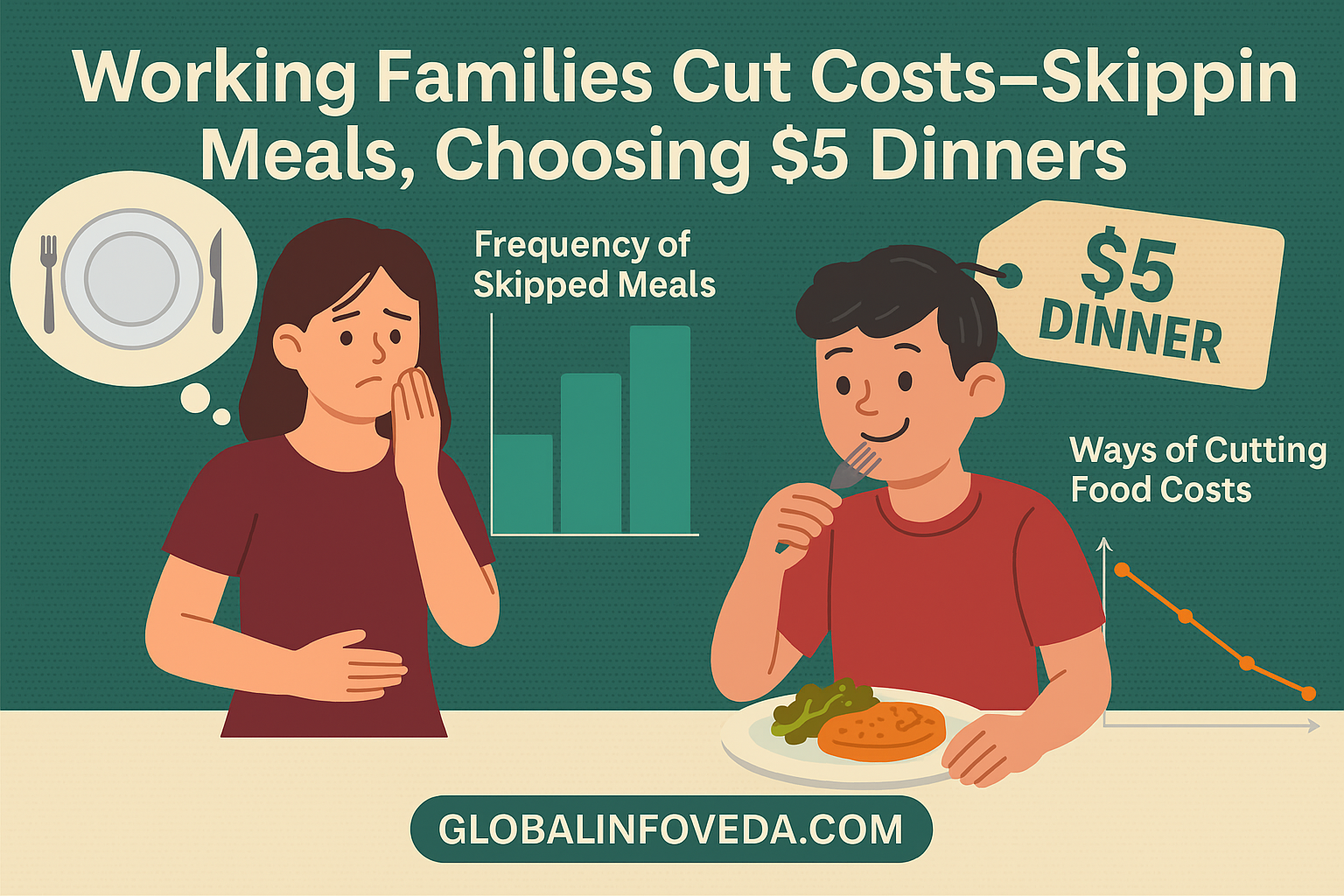Working Families Cut Costs—Skipping Meals, Choosing $5 Dinners
🏛️ Introduction: Survival in an Era of Inflation and Tariffs
Across the U.S., working-class households are facing stark and often painful decisions as inflation and tariff-driven price hikes erode purchasing power. Grocery bills are at record highs, utility costs continue to climb, and wage growth lags far behind. For millions, cutting back is no longer about giving up non-essentials—it’s about deciding which basic needs to meet and which to forgo.
This expanded analysis delves into the deep human impact of these economic pressures, the trade policies amplifying them, and the long-term social and economic consequences if current trends continue unaddressed.
📊 Big Picture: The Cost Squeeze on Working Families
- Food Prices: Up 13% year-over-year, with staples like bread, milk, eggs, and fresh produce seeing the sharpest increases.
- Housing Costs: Rent and mortgage payments consuming 35–45% of median household income in metro areas, squeezing disposable income.
- Utilities: Electricity and heating bills up 12% YoY, driven by higher energy tariffs and volatile global fuel markets.
- Healthcare: Insurance premiums up 8% YoY, with deductibles and out-of-pocket expenses rising even faster.
- Wages: Real wage growth at -1.2%, reversing modest gains from 2023–2024.
📌 Context: Tariffs on imported food, agricultural inputs, and energy sources have layered additional pressure on already fragile supply chains, inflating prices for basic goods and eroding family budgets.
🔍 Everyday Adjustments: How Families Are Coping
1. Food Budget Cuts
- Transitioning from fresh produce to frozen and canned alternatives.
- Relying on $5 dinner meals—often processed and calorie-dense—for affordability.
- Skipping meals, especially breakfast or lunch, to stretch food supplies.
- Buying discounted, near-expiry items in bulk.
2. Housing and Utility Adjustments
- Sharing housing with extended family or friends to cut rent.
- Limiting use of heating, cooling, and high-energy appliances.
- Moving to smaller or less desirable neighborhoods to save costs.
3. Healthcare Sacrifices
- Postponing preventive care and routine check-ups.
- Choosing generics over brand-name prescriptions.
- Splitting medication doses to extend supply.
4. Transportation Trade-offs
- Selling secondary vehicles to generate cash.
- Carpooling or shifting to public transport.
- Reducing travel to essential purposes only.
💵 Economic and Social Impact Analysis
- Nutritional Decline: Greater reliance on cheap, processed foods increases risks of chronic diseases.
- Community Strain: Food banks, shelters, and charities report demand spikes of 30–45%.
- Retail Slowdown: Non-essential retail sectors face declining sales, threatening small business viability.
- Healthcare System Pressure: Deferred treatment leads to worsened health outcomes and higher long-term costs.
- Workforce Productivity Loss: Stress, fatigue, and poor diet reduce work efficiency and attendance.
- Generational Effects: Limited resources for education and extracurricular activities hinder children’s development.
📈 Historical Context
- 2008–2009 Recession: Mass unemployment forced widespread budgetary cutbacks.
- 1970s Inflation Crisis: Rising food and fuel prices permanently reshaped household consumption patterns.
- COVID-19 Pandemic: Supply disruptions and price shocks pushed families toward stockpiling and cheaper shelf-stable items.
📊 Comparison: Meal Costs Before & After Tariffs
| Meal Type | 2023 Price | 2025 Price | % Increase |
|---|---|---|---|
| Fresh produce salad | $4.50 | $6.20 | +37% |
| Chicken stir-fry | $6.80 | $9.10 | +34% |
| $5 budget dinner | $3.80 | $5.00 | +31% |
🏛️ Policy & Relief Measures: Addressing the Crisis
1. Targeted Food Tariff Cuts
- Eliminate or reduce duties on key food imports to lower retail prices.
2. Nutritional Assistance Expansion
- Increase SNAP benefit amounts and expand eligibility thresholds.
3. Utility Subsidies and Energy Efficiency Programs
- Offer targeted subsidies and fund efficiency upgrades to cut recurring bills.
4. Affordable Housing Incentives
- Expand rent assistance and incentivize developers to build low-cost units.
5. Accessible Healthcare Solutions
- Support mobile health units, telemedicine, and preventive care outreach.
6. Community Resilience Programs
- Fund local food cooperatives and urban farming projects to improve access to fresh produce.
🔮 Final Insight: Beyond Survival—Restoring Stability
Working families are displaying remarkable resilience, but the coping mechanisms they employ carry long-term risks for health, education, and social mobility. Without urgent, targeted policy interventions—especially those reducing tariffs on essential goods—the budgetary squeeze could widen inequality, weaken community networks, and stall economic recovery.
📡 Follow GlobalInfoVeda.com for ongoing analysis of trade policy’s real-world impact.
